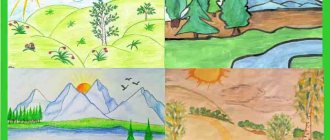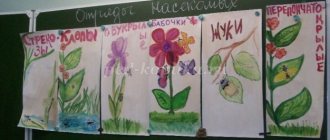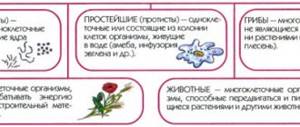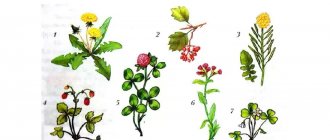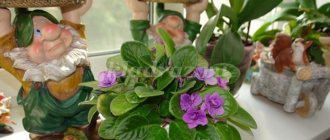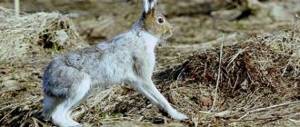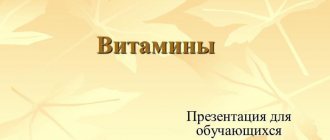Slide captions:
Forest animals Description, features of the appearance of forest animals.
Hedgehog Hedgehog is a small animal. The hedgehog lives in mixed and deciduous forests, preferring forest edges, clearings, and thickets of bushes.
White hare The white hare lives in taiga and mixed forests; prefers spruce areas with deciduous undergrowth and grass cover. It can be seen in overgrown clearings and burnt areas, in thickets of willow along the outskirts of swamps.
Chipmunk The animal is slightly smaller than a squirrel. The hind legs are slightly longer than the front ones. The tail is less bushy than that of a squirrel. The chipmunk prefers to live in coniferous forests on the edges, in bush thickets, in burnt areas and clearings, wherever there is dead wood.
Wolf The wolf is a large animal with relatively high and strong legs; the muzzle is elongated, the ears are pointed. The wolf is widespread throughout our country, except for some islands of the Arctic and Pacific oceans. The wolf lives in forest, forest-steppe zones, even in the steppe, but prefers sparse forest areas
Wild boar Lives in mixed and deciduous forests, along the banks of forest rivers and lakes. Wild boars live in herds, sometimes consisting of several dozen animals. They are active mainly at night, and during the day they sleep under the protection of trees or in thickets of bushes and tall grasses.
Elk Elk is a typical forest animal; it prefers young forests, overgrown burnt areas and cutting areas located among areas of old forest, as well as floodplain forests with dense thickets of willow near forest swamps and reservoirs rich in wetland vegetation.
Squirrel The common squirrel lives in taiga, mixed and deciduous forests. In summer it is active in the morning and evening hours, and in winter - throughout the day.
Fox The fox lives in various parts of the forest, but avoids dense areas, preferring the edges of mixed forests, old clearings and burnt areas, the banks of forest rivers and lakes.
Brown bear The favorite habitats of the brown bear are taiga coniferous forests, less often - deciduous forests with abundant windbreaks.
Badger The badger lives in mixed forests, preferring edges, copses, and forest ravines.
Common shrew Externally, the animal resembles a mouse or a vole, but has a pointed muzzle with an elongated proboscis, small ears and tiny eyes. The shrew lives in coniferous, mixed and deciduous forests, preferring damp, difficult to navigate areas. Often found in floodplains of forest rivers and streams, in forest ravines.
Crossword “Forest dwellers” 2 3 2 3 4 4 1 2 3 2 3 4 4
Beasts of the forest Author: Suvorova Ekaterina, 3rd grade student at Belyanitskaya Secondary School. - presentation
Beasts of the forest Author: Suvorova Ekaterina, 3rd grade student of Belyanitskaya Secondary School
The common squirrel is a small, beautiful and dexterous animal with an elongated body and a very fluffy tail. The length of its body is cm without the tail, and cm with it, the weight of an adult animal varies from 250 to 340 g.
The body fur of squirrels can be divided into winter and summer. Its change is called molting and occurs 2 times a year. Winter fur is tall, soft and fluffy, while summer fur is the opposite - tougher, thinner and shorter.
The squirrel is an inhabitant of forests and parks. It prefers mixed coniferous-broad-leaved forests, since its main diet consists of seeds of tree species of plants, such forests provide the best food supply for it. The lifestyle of this animal is predominantly arboreal. The squirrel is a living and very active animal.
Squirrels molt twice a year with the exception of the tail, which sheds only once a year. Spring molt occurs in April-May, and autumn molt in September-November. Its timing depends only on meteorological conditions and the availability of sufficient food supply.
In appearance, the chipmunk is similar to a small squirrel. Although in terms of family ties it is close to the typical ground-dwelling ground squirrels and marmots, since its body structure features are quite “arboreal”.
So, a chipmunk has a big difference in the length of its hind and front legs, rather large ears, and not so long claws.
The body length of the Siberian chipmunk is up to 170 mm, and the tail is 130 mm, since it is always more than half of the body. The thick hair that covers the bottom of the tail, less distinct than that of squirrels, is combed on both sides.
More than 25 subspecies of wild boars are known, but they all have the typical appearance of a stocky animal with a body length of cm, a height of up to 100 cm, rarely a little more and a body weight of more than kg (up to 275 kg). The head is very large, wedge-shaped, extended forward
The ears are long and wide, the eyes are small, and the snout has a snout. The body is covered with elastic bristles, longer and denser in winter, with underfur. On the back, the bristles form a ridge that puffs up when the animal is excited. Color ranges from light brown or gray to almost black.
In summer, wild boars can often be seen in fern-sedge forest swamps, swampy forests, reed thickets, and water meadows. Depending on whether the winter is severe or not, wild boars stay in winter mainly in spruce, mixed deciduous-spruce or spruce-pine forests.
The structure of the musculoskeletal system differs slightly more, depending on the genus to which a representative of the hare family belongs. The skull of some genera is more flattened and massive, while in others, on the contrary, they have a slightly swollen brain capsule, i.e. the entire skull is lighter.
The maxillary bones have a lattice structure. Unlike pikas (which are very similar to hares in appearance), the nasal bones of hares do not expand at all in the forward direction. The frontal bones (in particular their supraorbital processes) are also highly developed.
The auditory tympani are round in shape and moderate in size; the posterior process of the zygomatic bone is quite short, so it does not reach the auditory tympanum itself. The mandibular bone in representatives of all genera is very wide.
Both mandibular bones are connected motionlessly. The anterior part of the mandibular branch is raised upward, and along it there is a wide plate, this is the coronoid process
Foxes are one of the most attractive predators: red fur, a long and fluffy tail, a narrow and long muzzle, as well as cunning and intelligent eyes.
In size, a fox is similar to a small dog. The tone of fox fur coats varies from gray to fiery red.
A wolf is a mammal, a predator of the canine family. The word “wolf” itself leads to Proto-Indo-European roots. Wolf, coyote, and jackal belong to a small genus of wolves. According to the results of genetic drift and DNA sequence studies, he is the direct ancestor of the domestic dog.
And she, in turn, is a subspecies of wolf. In the canine family, the wolf is the largest animal: body length - 160 cm, height at the withers - 90 cm; weight – 62 kg.
Bears (lat. Ursidae) belong to the order of the predatory family of mammals. They stand out among other representatives of their species due to their strong physique. Bears can walk and stand on their hind legs, run fast, swim and climb well.
They usually eat berries and mushrooms, but they do not disdain meat; they also love fish and honey. Immune to bee stings. They have an excellent sense of smell and hearing, long thick fur, and a short tail.
They usually hunt at dawn or in the evening. They are afraid of people, but where they are accustomed to the presence of humans, they can be extremely dangerous. Especially the grizzly bear and the polar bear. In nature they have practically no enemies.
Place.800x600w.jpg?5fe31f489fcfcf955eb9ac9c7a42b630https://priruchi.ru/files/products/writingImag_Geolocation-Finding-Your-Happy-or-Brutal- Place.800x600w.jpg?5fe31f489fcfcf955eb9ac9c7a42b 630 squirrel about squirrel chipmunk bear chipmunk boar boar jpg boar boar jpg boar boar jpg hare hare jpg fox fox wolf jpg wolf
On the topic: methodological developments, presentations and notes
Lesson about the world around us in 3rd grade. Topic: Consolidation of the material covered on the topics: “Ecosystems of forests, lakes, swamps and meadows.” NRK "Animals and plants of ecosystems of forests, lakes, swamps and meadows of Chelyab
A lesson to consolidate the material covered on the topics: “Ecosystems of forests, lakes, swamps and meadows.” NRK "Animals and plants of ecosystems of forests, lakes, swamps and meadows of the Chelyabinsk region." Organization of a lesson on t...
During the lesson there is a conversation about the diversity and life of plants, the benefits they bring to humans, the need to protect the flora of our Motherland, the rules of behavior in the forest; improve...
“Tundra Natural Zone” - What do you think is the reason for the extreme vulnerability of the northern treeless zones? But the average temperature in July is +5...+10? C. What patterns exist in the distribution of natural areas? Large areas are occupied by swamps. Lesson plan: Relationships in the natural complex of the tundra. In places of deeper thawing, shallow basins filled with water appear.
“Savannas and woodlands” - Flora. Savannas and woodlands are located on all continents except Antarctica. Each continent has its own unique flora of savannas and woodlands. Savannas and woodlands. Formed during the rainy season: the soil is washed out. America. Soils. Wet. Africa. South America. Natural area of savannah and woodland.
“Tundra and forest-tundra” - Yamalo-Nenets Autonomous Okrug, Subpolar Urals. What is the difference between tundra and forest-tundra landscapes? Describe the GP zones of tundra (2) and forest-tundra (3). Describe the climatic conditions in the tundra and forest-tundra zones. 1. What are tundra soils called, what are the features of soils in the tundra zone? Crowberry (black crowberry, crowberry). 3. Cotton grass.
“Broad-leaved forests” - Climate. Nature reserves have been created to preserve flora and fauna. taiga on the Russian Plain, absent in inland ones. Geographical location: Forests are characterized by a tiered distribution of animals. regions and reappears in the southern part of the Far East. Fauna: The climate is warmer than in the taiga, the vegetation is more diverse.
“Grade 6 Geography Glaciers” - Which lake is the largest in area? Border separating river basins? Hubbard Glacier (Alaska). What types of lake basins do you know? How is groundwater formed? Icebergs. The village of Nizhny Karmadon was completely destroyed. Monument to those killed as a result of the collapse of the Kolka glacier. In what form is water found in the solid state?
“Animals of the Arctic” - Animals of the Arctic. We are going with you again to where the kingdom of cold, snow and ice is! Walruses. An animal that appears in the northern seas in summer. Conclusion 2: the sea feeds the animals. Whale. Bears are rubbing their backs - the Earth is spinning. The Arctic is located... But even in summer the sun's rays are only... The polar bear lives on snow and ice, therefore...
“Deserts and semi-deserts” - In rare places in deserts, where groundwater comes close to the surface, oases form. Desert animals live in burrows or burrow into the sand. Oases. Other animals, such as camels, can go without water for long periods of time. Animals. Types of deserts. Content. Plants. Desert inhabitants.
"Palaearctic region" - Deciduous forests Animals. Coniferous forests Plants. The flora is represented by low-growing vegetation: mosses, lichens, sedges, stunted shrubs. Tundra Animals. The fauna is represented by: Lynx, wolverine, moose. Tundra Plants. The plants are mainly beech, oak, hornbeam, and linden. Steppe Animals. Hard-leaved forests Animals.
“Forest Resources of the World” - Plant Resources of the World. Importance of forest resources. Heavily wooded. Quantifying the world's forest resources. Rational use of forest resources. Lightly wooded. 10 – 50%. The total forest area in the world is 4 billion hectares. Medium wooded. Less than 10%. Guiana (French) Suriname Mozambique Japan Ecuador Congo Myanmar.
“Steppes and forest-steppes” - Xerophytes - drought-resistant plants. Forest-steppes and steppes. Thyme. Ephemeroids are perennial herbaceous plants. Wormwood mullein. Salvia veronica. Tasks: Irises. Landscapes of the past. Ephemera are annual, small herbaceous plants. Animals of forest-steppes and steppes. New concepts: Plants. Adonis. Ermalaeva M.N.
To use presentation previews, create a Google account and log in to it: https://accounts.google.com
Forest inhabitants and secrets of the forest (Video)
MOLDOVENII.MD
A stunningly beautiful film about the life of a temperate forest. Previously, our forests were never completely dense and dark, but were a mosaic of groves, clearings and sunny meadows. In such forests there was more light, warmth, different biotopes and, as a result, a huge variety of animals and plants. The film very beautifully and educationally shows the life of the forest and its inhabitants throughout the year.
The earth is full of beautiful places, and although people cut down more and more nature reserves every year, using trees for kindling, nature is restored and gives the inhabitants newer and no less colorful places. It doesn’t matter where perennial trees grow - in the lowlands or near the river bank - here you can always find exotic animals and unique representatives of the flora.
In the documentary film “Myths of the Forest,” viewers are shown the beauty of pristine nature, which man has not yet reached. In the company of professional cameramen, viewers go on an amazing journey through the colorful places of our planet in order to see with their own eyes the magic and riot of colors.
Surrounded by tall trees, we inhale the wonderful aromas of plants, enjoy the stunning sounds and singing of birds. The authors decided to collect the most unique footage in the presented work, which will allow us to reliably observe the process of the origin and development of life. Looking around, you are horrified by what you see: giant skyscrapers, hundreds of cars polluting the atmosphere, people rushing about their business... And only on the screen do magnificent landscapes shine that can give a lot of pleasure to everyone who treats nature with respect.
List of episodes:
1. Animal paradise and the kingdom of shadows
2. Fight for light
➁ Wonderful forest
A documentary that explores the primeval forests of Northern Finland, some of the last remaining ancient forests in Europe. The film also shows the diverse and rich life of the forest inhabitants.
➂ Film by Igor Byshnev “The Great Forest”
The film by Belarusian director Igor Byshnev “The Great Forest” is about one of our natural resources - the forest.
For many millennia, the forest occupied a leading place in the natural world. No natural forces: fires, windfalls and windfalls could “conquer” the occupied territory from him. One generation of trees was replaced by another, some species gave way to others, but the forest always firmly retained its leading position.
And only man, cutting into forests for centuries, forced him to retreat.
➃ Secrets of the taiga. A film about beauty and greatness!
The film introduces the animal and plant world of the taiga. A documentary film about the beauty and wildlife of the majestic taiga, stretching over 7 thousand km in the foothills of the Urals.
➄ Wild life of Alaska. Pristine nature
Documentary film about the wild nature of the lands that occupy Alaska. Alaska's wildlife world is quite harsh. This is due to the very frosty climate. Only the strongest survive. As a result of natural selection and evolution, truly unique and resilient animals that are breathtaking in their beauty have survived and exist in Alaska.
➅ Bear stories
This story took place in the forests at the foot of the Carpathian Mountains. The story of two bear cubs who lost their mother is like a fairy tale. They cannot survive alone in the forest. But a miracle happened: the orphaned cubs were found. The person who saved the twins from starvation will try to make their life comfortable and safe. But is this possible? Will wild brown bears become obedient pets living in the deep forest?
➆ BBC World of Nature. Iten - a protected forest / The Natural World
Nature never ceases to amaze the imagination with its miraculous wonders. Some of them were created over millions of years of evolution. We will get to know amazing places and their equally amazing inhabitants. In these untouched corners of the earth, they still obey one law - the law of nature. Animals do not argue, but is man ready to follow it? This stunningly beautiful documentary series about wildlife is a two-time winner of the prestigious RTS Award. Excellent shooting and full awareness allow you to experiment in choosing the theme of the series and its presentation. Episodes featuring human-animal interactions focus on traditional themes of species and their natural habitats.
➇ Belovezhskaya Pushcha. History of the forest. Bison rescue. Flora and fauna.
➈ Krasny Bor
The first full-length popular science film about the natural complex “Krasny Bor”. Belarusian Poozerie. The plot is based on the creation of new wild micropopulations of bison and red deer in the north of Belarus.
Slide captions:
Have you ever been to the forest? How do you understand what a forest is? What trees grow in the forest? Plants and animals of the forest.
A forest is a vast area covered with trees and shrubs.
What groups can these trees be divided into?
Coniferous trees. Deciduous trees.
needles leaves Coniferous trees have needles instead of leaves, which are replaced gradually over several years and therefore the trees are always green, while deciduous trees have leaves that the trees shed in the fall.
What are the names of forests in which only deciduous trees grow? Deciduous forests.
What are the names of forests in which only coniferous trees grow? Coniferous forests.
What are the names of forests in which coniferous and deciduous trees grow? Mixed forests.
What other plants grow in the forest you will answer by guessing the riddles. If you touch it, it’s like fire. You better not touch her. It burns your hands and feet - Be careful with it on the road. The smell of forest freshness brings us in late spring. A fragrant, delicate flower from a snow-white brush. lily of the valley nettle
Soft, not fluffy; Green, not grass. In the summer I am glad to have fresh bear berries; And dried as a reserve, it cures us from colds. raspberry moss
I am a drop of summer on a thin leg. They weave bodies and baskets for me. He who loves me is glad to bow. And the name was given to me by my native land. What kind of bead is hanging here on the stem? If you look, your mouth will water, And if you bite through, it will be sour. strawberries lingonberries
Look carefully at the plants that grow in the forest, except for trees. What groups can they be divided into?
Herbaceous plants. Shrubs and Mosses. shrubs.
What plants grow in the forest? trees shrubs herbaceous plants mosses
Tiers of the forest. All the plants that make up the forest are located in the forest in steps, or tiers. Some forests even have more than five tiers. The first tier is trees. Its height reaches thirty meters or more. The second tier is shrubs. The third tier is shrubs (for example, lingonberries). The fourth tier is herbaceous plants. The fifth tier is mosses and lichens.
Medicinal plants. male fern nettle blueberry henbane black celandine great dandelion medicinal centaury common tansy
Find out and name the inhabitants of the forest. owl boar fox sable cuckoo elk hare woodpecker hedgehog bear squirrel
Do the crossword puzzle. 1.Animal is the national pride of Russia. 2 4 3 5 6 7 9 8 1 10
2. Plants of the lower tier. l o b o s 4 3 5 6 7 9 8 10 2
3.Middle tier plants. l o b o s i m x 4 5 6 7 9 8 10 3
4.Long ear, ball of fluff. Jumps deftly, gnaws carrots. b l o s i m h k u i n s t a 5 6 7 9 8 10 o r 4
5.What is the name of the forest in which oak, birch, maple, and linden grow? l o b o s i a r h k c y z k u i n s t a 6 7 9 8 10 5 m
6. Plants of the upper tier. l o b o s i m n a r h e c t y a z k u i n s t i l e s y n t v 7 9 8 10 6 a
7.What is the name of the forest in which spruce and pine grow? l o b o s i m a n a r h e c t y a z k u i n s t a v e i l i s y n tv d e r 9 8 10 7
8.What bird is called the forest doctor? l o b o b o s i m i a n a r h e c t i o l a z k u i N st a v i e l i s i n t o u n d e r h v 9 10 8
9.What is the name of a forest in which deciduous and coniferous trees grow? l o b o b o s i m i a n a r h e c t y a z k u i N st a v i e l i s y n t o u n d e r e l h v i a t 10 d 9
10. Get into the habit of going into the poultry house - expect trouble. Covers his tracks with his red tail. l o b o b o s i m i a n a r h e c t y a z k u i N st a v i e l i s y n t v o u n d e r e l h v w m i t u n n a i d s 10
Do the crossword puzzle. l o b o S i m i a n a r h e c t y a z k u i n s t a v i e l i s y n t v o u n d e r e l h v w s m d i t y n n a al i y
Forest protection. The importance of forests in our lives is great. The forest provides wood. Game animals and birds live in the forests, mushrooms, berries and wild fruit trees grow. The soil covered with forests retains moisture well. Forests keep rivers full, protect the soil from destruction, and prevent landslides in the mountains. Forests protect fields from dry winds and dust storms. Forests beautify the earth and purify the air. Therefore, forests must be protected and protected from fires and deforestation. Create reserves for rare plant species. Popular wisdom says: “A person has not lived his life in vain if he has grown at least one tree.”
Homework. 1.Draw a poster on the topic “Protect the forest!”
Forest and its inhabitants
Author: Razumovskaya Natalya Petrovna, primary school teacher, Municipal Educational Institution "Poddubnovskaya Secondary School" p. Poddubnoe, Inzensky district, Ulyanovsk region
Lesson of the surrounding world in 3rd grade according to the educational complex “Prospective Primary School”
Lesson Objectives:
cognitive UUD:
- begin to get acquainted with the forest as a natural community;
- generalize and systematize knowledge about the forest;
- compare your capabilities and the capabilities of cross-cutting heroes (Kosti Pogodin)
- learn to search for and highlight the necessary information in the text;
- teach to establish cause-and-effect relationships based on microresearch:
- describe, on the basis of an illustration or a proposed plan, the studied objects and phenomena of living nature, highlight their main essential features, highlight what is new;
- use the textbook's dictionary;
personal UUD:
- work on the development of educational and cognitive motives;
- work on developing a reflective attitude towards learning;
regulatory UUD:
- learn to set goals for upcoming work;
- learn to distinguish between educational tasks of different types;
- learn to control your learning activities, detect and correct errors, exercise control;
- learn to evaluate yourself and your comrades;
communicative UUD:
- improve the ability to work in pairs and in a group;
- learn to carry out educational cooperation;
- learn to work as consultants, provide mutual assistance as the task progresses;
Equipment: presentations, textbook, reader, notebook for independent work, map of vegetation of the Tver region.
During the classes:
1. Org moment.
— You looked at the guests, smiled and sat down quietly.
2. Message topic and goals.
— Children, determine the topic of today’s lesson. (by table of contents)
Forest - and its inhabitants.
— Today we are starting a new chapter “Natural Communities” and a new topic “Forest and its inhabitants” page 43 textbook
—What communities will we study in this chapter? (see community in Ozhegov’s dictionary)
— What lesson goals will we set?
3. Updating of ZUN. (icon “Repeat what you’ve covered”)
page 43 textbook
— What plants and animals of the forest do you know about from books?
— Is there a forest in your region?
— Is it taiga, mixed forest or deciduous forest? (footnote to dictionary)
- Work in pairs using the dictionary at the end of the textbook.
- Let's determine the meaning of these words using the dictionary at the end of the textbook.
- Working with a vegetation map of the Tver region.
— What forests predominate in our region? Determine by background.
(mixed, spruce-broadleaf, birch and aspen, pine forests)
Presentation “What is the forest like at different times of the year?”
— Our district, and in particular the Tver region, is located in a forest zone, in the subzone of the southern taiga, turning into mixed broad-leaved and coniferous forests.
— What plants are found in our forests?
- Animals?
4. Working with the text of the paragraph.
page 43
- What is a forest?
The forest is called the “kingdom of trees.” But the forest is impossible to imagine ___________________
("Make a Guess" icon)
— Kostya Pogodin noticed that in the forest, plants of different heights grow in several “floors,” or tiers. Children, do you agree with Kostya’s opinion? (see Ozhegov's tier in the dictionary)
(children express different opinions).
Physical pause ________________________________________________
5. Commented reading. Listening to micro-studies. Presentation “What trees live on different tiers in our region?”
The upper tier - tall trees - light-loving.
Oak, linden, birch, maple, aspen, pine, spruce.
Below are low-growing trees - shade-tolerant.
Rowan, bird cherry, willow.
The third tier is shrubs.
Raspberry, viburnum, honeysuckle, hazel, rosehip, buckthorn.
Below the bushes are blueberry bushes, lingonberries and herbs - lily of the valley, sorrel.
All are shade tolerant.
The lowest tier is mosses and lichens.
6. Work in the anthology on the text “What is a forest?”
Work in groups.
— Children, where can I quickly find the text in the reader?
(by table of contents) page 85 reader
— We sit down in groups. We receive tasks.
Questions:
- How many tiers are there in a mixed forest?
- What plants are located in the first tier and below? And what is undergrowth?
- What plants are located on the lowest last floor? (this is the soil, the roots of the green inhabitants are hidden in it)
- What plants cannot be classified into any tier in the forest? (teenager)
- Which trees and shrubs in a mixed forest will never be able to rise above the third or second tier during their life? (spruce, fir, cedar, rowan, bird cherry, buckthorn, viburnum)
- Pictogram “Make a guess ”. Reading a passage of text.
7. Work according to the textbook.
— Layering helps plants live side by side without interfering with each other.
page 45 textbook
- Drawing work. Pictogram “Work in pairs.”
pp. 45-46 textbook
— Tell us, what animals live and on what tier?
- Reading the text of paragraph pp. 47-48 to expand and complement the children's answers.
Individual task.
Work in the anthology p. 91 text “Who lives in a tree in the forest, and who lives under a tree?
9. Fixing the material.
Work in a notebook for independent work.
No. 18 p. 16 . Complete the animals. (work of consultants)
10. Homework.
— We will continue to work on this topic. For the next lesson, prepare research on the topic - little-known facts about the following animals:_________________. Be sure to talk about natural enemies and animal nutrition.
12. Summary.
— What new did you learn?
— Have you achieved your goals?
— What interesting things did you learn?
13. Analysis. Grading.
On the topic: methodological developments, presentations and notes
Local history lesson in group form. Groups: “Botanists”, “Ornithologists”, “Entomologists” “Zoologists”, “Ecologists”….
A presentation on the surrounding world using the “Planet of Knowledge” educational complex will give you the opportunity to carry out practical work in an interactive form, travel along a map of the forest, test your knowledge….
A lesson on the surrounding world on the topic “Plants and animals of the forest” is intended for children in grade 4. Can be used when working with any teaching materials. The lesson material helps children deepen their knowledge in a playful way...
Presentation on the topic: “Fauna of a mixed forest”Presentation prepared by: 8G grade student Tatyana Koval
Why is the mixed forest so diverse in fauna?
The diversity of vegetation in this zone is explained by differences in climate: temperature, amount of precipitation and precipitation patterns, and they are also resistant to negative environmental influences and have a mosaic structure. Mixed forests have a clearly visible layering. 1) The lynx has a rather interesting attitude towards a person, it can easily break his neck, but at the same time, it avoids people and does not attack them; 2) Lynx never attacks from above; hiding on tree branches or on rock slopes, they track their prey or rest; 3) Wolves distinguish about 200 million shades of smell, people only 5 million.
